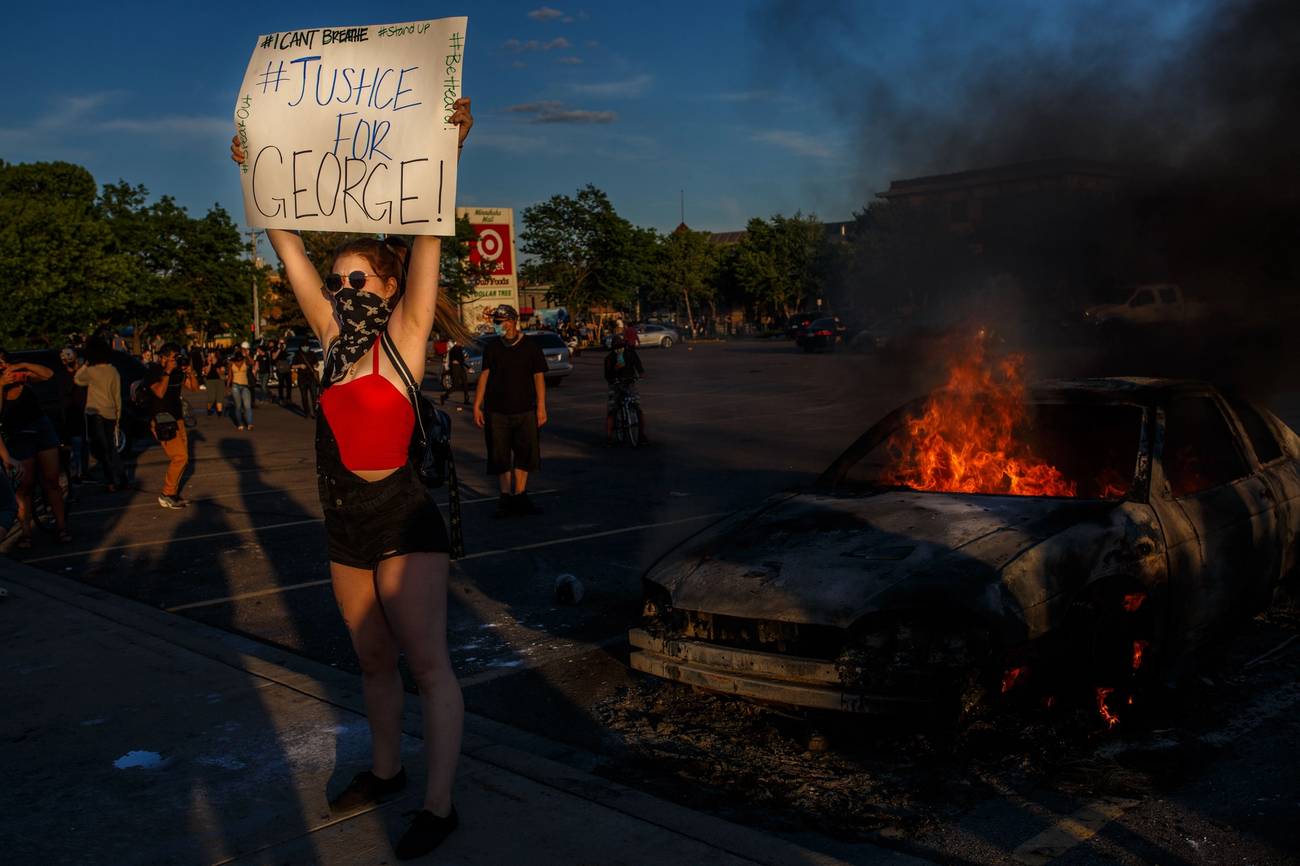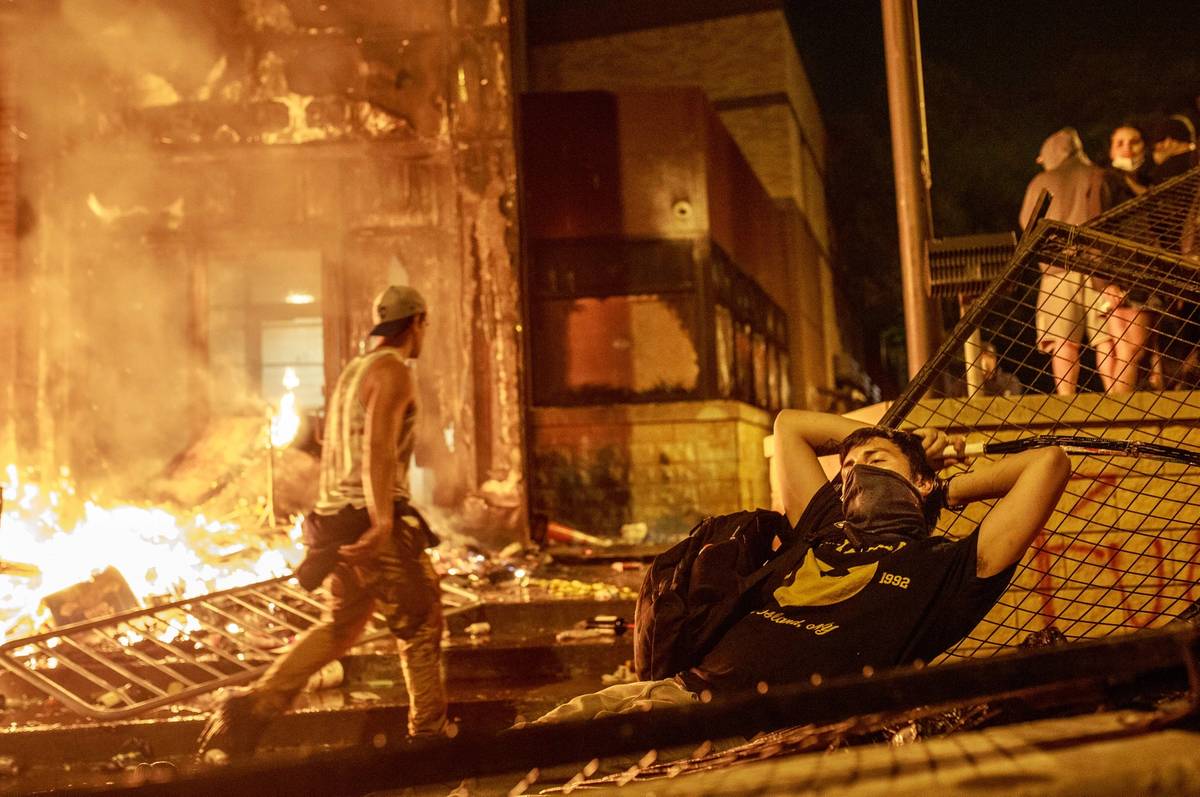Hub City Riot Ninjas
A young overclass gets dressed up to join the burning



What is behind the riots? The violent riots emerging from peaceful protests that have swept liberal, Democratic big cities across the United States in the aftermath of the horrifying death of George Floyd in the custody of the Minneapolis police on May 25 can only be understood in the context of the evolving class structure of American and Western European society. In my recent book The New Class War and the essays on which it was based in the journal American Affairs, I have explained that in the United States and other North Atlantic democracies, the greatest geographic divide is between high-density hub cities and low-density heartlands. The riots are a hub city phenomenon—and so are their most striking participants, affluent young white rioters dressed like ninjas.
Most factories, warehouses, distribution centers, and new industrial structures like server farms are located in the low-density heartlands, along with industrialized agriculture and energy and mining. The class system in the heartlands tends to be more egalitarian, if only by default, because these regions have relatively fewer rich and poor people as a share of the population than working-class residents. Native-born white citizens are the majority in the decentralized exurban heartlands. However, contrary to the outdated equation of “urban” and “minority” and “poor,” most African Americans and Hispanic Americans belong to the working class and live in the suburbs, exurbs, and small towns.
The hub cities have a radically different social structure than the heartlands. At the top are affluent members of the managerial-professional overclass, which includes well-educated immigrants as well as natives. Their incomes vary, but people with college or post-graduate educations dominate the upper rungs of corporate management, finance, business and professional services, government and the nonprofit sector in hub cities like New York, Washington, San Francisco, Atlanta, Seattle, and Austin.
As young adults, the children of the overclass often spend their 20s in the same few cities, living in gentrified bohemian neighborhoods that used to be factory or tenement districts. Often as they work their way up the cursus honorum of their class, they benefit from elite apprenticeships in the form of unpaid or underpaid internships, which are not available to young people whose parents cannot afford to subsidize them.
The greatest social divide in the United States is that between the overclass with at least a four-year college education, about a third of the national population, and the working class whose education ends with a high school diploma and perhaps a few more years of education or vocational training, regardless of income. These broad categories can be broken down further.
In hub cities like New York and San Francisco, the overclass is divided between what might be called the upper overclass—the well-paid managers and professionals in business and finance—and the lower overclass—made up of civil servants like public school teachers and government administrators who accept modest salaries in return for de facto job tenure and good benefits, including public pensions.
The hub city working class is even more fragmented. Foreign-born immigrant diasporas provide much of the low-wage workforce. In New York and Los Angeles and San Francisco, between 30% and 40% of the residents are foreign-born. Some of these immigrants are self-employed and own businesses, but many of them work as menial domestic servants, health aides or insecure gig workers without fixed schedules or employer-provided benefits.

In addition to immigrant diasporas, in many American cities there are pockets of concentrated African American poverty. Many of their residents are descendants of people who migrated from the rural South between WWI and the 1960s to work in industries that no longer exist or have been offshored to other regions of the United States or other countries. Following deindustrialization, many of these families have lacked the resources to move. Trapped in derelict neighborhoods, they suffer from a lack of employment, poor access to amenities like stores, and local organized crime, in addition to the effects of real but gradually diminishing racism in American society as a whole.
Finally, what might be called the “upper working class” in hub cities is dominated by a different group of public servants, particularly police, first responders, and jail and prison guards. This stratum of the working class increasingly is racially diverse. Law enforcement officers tend to be from working-class families, but are unionized and tend to earn more and have better benefits than low-income immigrant workers or the native urban poor. In some parts of the country the police and fire fighters can afford to live in low-end suburbs and commute to work in the cities.
The two groups that dominate the public sector—the lower overclass of civilian public servants and the upper working class of law enforcement personnel and first responders—form a kind of human barrier between the mostly nonwhite poor and the mostly white economic elite in American hub cities. Public school teachers interact on a daily basis with low-income urban student populations, while many affluent whites, including elite progressives, put their kids in private urban schools or suburban schools. Meanwhile, police and first responders are summoned on a daily basis to deal with crimes and disputes in the poor urban neighborhoods.
These interactions between the native and foreign-born urban poor and the frontline public sector employees in big cities can create suspicion and hostility on both sides. In order to qualify for means-tested programs like food stamps and Medicaid, poor people have to deal with civil servants in bureaucratic agencies who are often burned out and indifferent. Police forces and jails and prisons have always attracted some bullies and criminals, and the stress and danger of their jobs brutalizes others. The populations that are means-tested and policed often feel under siege while those doing the means-testing and policing can feel disrespected and endangered.
Thus the kindling accumulates until it is ignited by some incident at the interface between the urban public sector and the urban poor. Usually a police killing or beating triggers an eruption of protest in a hub city. Even if the protest is peaceful at first, it is often hijacked by criminal gangs for whom it is an opportunity for looting. This was the story of major U.S. urban riots between WWII and the 21st century. (Most so-called “race riots” in the United States between the Civil War and WWII were different; they were violent pogroms by working-class whites against black competitors for jobs and neighborhoods, who were sometimes brought up from the South by industrial corporations as strikebreakers.)
Beginning in the 1960s and the ’70s, with the Weather Underground terrorists, and continuing in the 1990s, with “black bloc” vandals traveling around the world to smash office and hotel windows at global financial meetings, there has been a violent subculture on the radical left in the United States and Europe. For the most part, the members of groups like Antifa, the latest incarnation of the violent left, have always been the pampered children of the white overclass. Twenty-somethings who are poor and working class lack the money to buy fancy black ninja outfits and the leisure to spend time plotting in advance of demonstrations. This is nothing new; as a veteran ’60s leftist told me, “Your Mom and Dad had to have a lot of money, for you to take part in the Summer of Love.”
What is new about the nationwide riots of the last week that have followed the death of George Floyd is the convergence of these two previously separate streams—traditional urban riots in poor neighborhoods triggered by police-related incidents, and the ideologically motivated vandalism by young white members of the overclass in downtown districts. This convergence is the result of hub city gentrification.
The deindustrialization of the cities and rising real estate prices have forced most of the working class of all races out of hub cities into low-income suburbs and exurbs. The children of the white urban elite—some of them downwardly mobile for life, some of them just going through the underpaid intern phase of professional careers—have colonized rowhouses where workers once lived and have converted former factories and warehouses into settings for la vie bohème.
This group of 20- and 30-somethings in the new urban bohemia are the constituency for the new progressive left. Children of the managerial overclass join the Democratic Socialists of America (DSA) and engage in purges and cancellations on Twitter and move to Brooklyn on allowances from their parents. They demand that the billionaires be soaked to pay for socialism (translation: Mom and Dad need to increase my allowance).
Gentrification explains why there are so many white young adults, both ordinary protesters and anarchist vandals, compared to African Americans in the videos we see of protests and riots in big cities across the United States, compared to images of urban riots in generations past. Thanks to rising rents, young white leftists and liberals have been displacing the nonwhite working class and poor, many of them social conservatives, in places like Brooklyn and Oakland and Austin. While the initial occasion of a protest may be the death of a member of a minority group in police custody, affluent young white leftists are more interested in symbolic violence against capitalism or patriarchy or whatever.
These children of the economic elite end up harming those on whose behalf they pretend to be speaking. Like the upper-middle-class hippies of the 1960s who called police officers “pigs,” today’s affluent hipsters despise the police, many of whom are their age but are more likely than leftist radicals to be from working-class backgrounds and to be nonwhite. Slogans of elite radicals like “Abolish the Police and Prisons” and comparisons of the Border Patrol to the Gestapo are insults to the unionized, working-class Americans of all races employed by those institutions.
Dressing up as revolutionaries like children on Halloween, the sociopathic heirs of the overclass, already living in neighborhoods from which the working class was forced out by economic privation, take part in the vandalization, looting, and burning of local businesses, many of them owned by immigrants or members of minority groups. If they get arrested, the fortunate among them can count on being bailed out after phone calls to their indulgent liberal or moderate conservative parents, who live in expensive, nearly all-white urban and suburban neighborhoods and denounce racism and fascism on their Facebook pages.
It will take years for the American hub cities damaged by the riots, along with the pandemic and the lockdown, to recover, if they ever recover. The black poor and working class first had their urban industrial jobs taken away from them by corporate executives in the white overclass who offshored them to Mexico or China. Then they were replaced in their former urban neighborhoods by the hipster children of the white overclass. Now even their grievances like protests against horrific police brutality are stolen from them by their supposed allies in the white overclass and turned into an occasion for virtue-signaling or vandalism by the elite.
Many of today’s big city riot ninjas will look back in the future with pride on their nights of prancing around in black leotards and spraypainting “BLM” and “Fuck Trump” on downtown buildings. A decade from now, the most successful will have well-paying jobs, many of them in the politically progressive sectors like the universities and NGOs. The unlucky ones may still be working at Starbucks—perhaps at the very stores whose plate glass windows they once spray-painted or smashed.
Michael Lind is a Tablet columnist, a fellow at New America, and author of Hell to Pay: How the Suppression of Wages Is Destroying America.